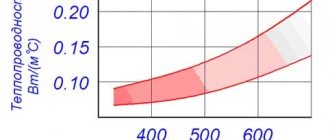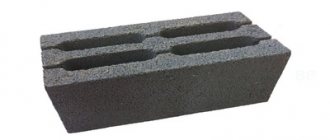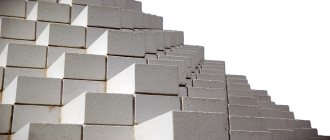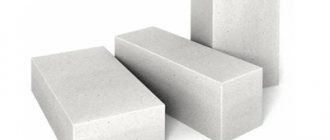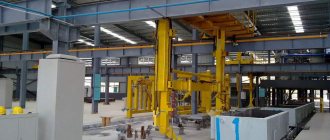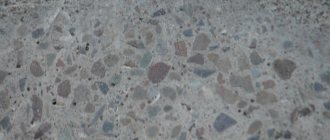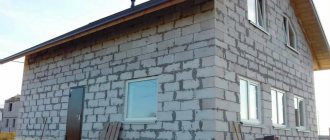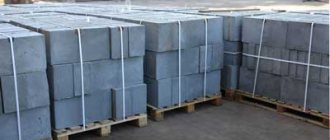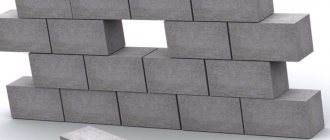Beton-House.com
Website about concrete: construction, characteristics, design. We combine the experience of professionals and private craftsmen in one place
Aerated concrete, thermal conductivity
Aerated concrete and products made from it have gained popularity due to their high properties and qualities, one of which is thermal conductivity. The material has a high ability to retain heat, which is due to the special structure, composition and technology of production of products.
Let's figure it out: the thermal conductivity of aerated concrete - what exactly does it depend on? What advantages will a structure built from this material have? And why do thousands of developers, despite high competition, prefer aerated concrete products, based primarily on thermal conductivity?
- Thermal conductivity indicators of aerated concrete. Dependence of thermal conductivity coefficient on technical and mechanical parameters
Brief characteristics of aerated concrete
Aerated concrete is a type of cellular concrete, and differs from similar wall materials in the composition of the raw materials and the method of pore formation. Despite its similarity to analogues, thermal conductivity and other properties sometimes differ significantly.
In order to understand what exactly can influence changes in the numerical indicators of characteristics, you should first consider the individual characteristics of the material.
Aerated concrete
Review of basic properties and qualities
Let's use the table.
Main characteristics of aerated concrete:
| Characteristic name | Its average value |
| Frost resistance | 35-150 |
| Strength grade | For a non-autoclave - from B1.5, in accordance with GOST 21520-89; for autoclaved aerated concrete, on average - B3.5 |
| Shrinkage | From 0.3 mm/m2 |
| Minimum recommended wall thickness | From 0.4 m |
| Thermal conductivity | From 0.09 |
| Environmental friendliness | 2 |
| Fire hazard | Does not burn |
The characteristics are quite competitive. However, they all fluctuate within certain limits and, as already mentioned, depend on certain conditions. The table shows the average and minimum values.
The thermal conductivity of an aerated concrete block is 0.09, which is typical exclusively for thermal insulation products in dry form. We will consider below how it will change with increasing density.
Classification and scope of application
Considering the topic of this article, it will be relevant to understand what types of material exist. After all, the thermal conductivity of aerated concrete blocks depends on many factors.
In accordance with the hardening method, an aerated concrete block can be:
- Autoclave;
- Non-autoclave.
Autoclaved and non-autoclaved aerated concrete
Note! Autoclaved aerated concrete is also called synthetic hardening aerated concrete. It differs in that at the final stage of production it is processed in special equipment - an autoclave, under high temperature and pressure. As a result, the products have higher characteristics, including a better ratio of density and thermal conductivity. But we'll talk about this later.
Non-autoclaved products, or hydration-cured aerated concrete, achieve technical strength in a natural way. The requirements for it, in accordance with GOST, are somewhat lower. Let's compare the performance of these types of aerated concrete using a table.
Comparison of autoclaved and non-autoclaved aerated concrete:
| Indicator name | Value for autoclaved aerated concrete | Value for non-autoclaved aerated concrete |
| Strength, brand | B2.5-5 | B1.5-2.5 |
| Frost resistance | 35-150 | 15-35 |
| Vapor permeability | 0,2 | 0,18 |
| Operating thermal conductivity | 0,096-0,155 | 0,17-0,25 |
| Fire resistance | Does not burn | Does not burn |
| Recommended minimum wall thickness, meters | From 0.4 | From 0.65 |
| Durability | Up to 200 years | Up to 50 years |
As you can see, synthetic hardening aerated concrete is in many ways ahead of its competitor, a non-autoclave, and this applies to almost all characteristics. It should be noted that the price of the latter is also much lower, and it can be made with your own hands.
Characteristics of aerated concrete of different densities
Aerated concrete is also divided depending on its density.
In accordance with this, the material can be:
- Thermal insulation. Such products are characterized by low density (up to 400) and thermal conductivity. They are used as a material for insulation, since the block is not able to withstand any significant loads.
- Structural thermal insulating aerated concrete has a higher density. The numerical indicator varies from 400 to 800. However, the thermal conductivity coefficient of aerated concrete blocks also increases. The material is used in the construction of walls and partitions.
- Structural aerated concrete is the most durable of all. Its density is 900-1200. It can withstand significant loads, however, the walls require additional insulation, since the ability to maintain temperature in such blocks is quite low.
Differences between aerated concrete of different densities
In addition to the above classifications, there are others related to the peculiarities of the composition and appearance of products. Let's take a brief look.
Depending on the type of binder, aerated concrete is:
- On a cement binder;
- On limestone;
- On slag;
- On ash;
- On mixed.
This indicates that the content of the main component varies from 15 to 50%.
According to the type of silica component:
- On the sand;
- On the ashes;
- On other secondary industrial products.
I would also like to note the classification based on the geometry of the block.
Aerated concrete can be:
- First category of accuracy;
- Second category of accuracy;
- Third category of accuracy.
The category indicates possible geometric deviations, the maximum values of which are dictated by GOST.
Important! Blocks of the first category are the most even, deviations in size should not exceed 1.5 mm. They are laid on glue with a minimum layer thickness. And note that for the thermal engineering of walls in general this has a significant impact!
The second category has large deviations: up to 2 mm in size, up to 3 mm in diagonal.
Blocks of the third category are usually used in the construction of outbuildings. Increased deviations dictate the need to construct walls using mortar with a significantly larger joint thickness. This increases cold bridges and thermal conductivity of the room.
Note! Blocks of different categories differ from each other only in geometric deviations. There are no significant differences in technical characteristics. Thermal conductivity, strength, frost resistance and other indicators will be identical. They can differ only due to comparison of products from different manufacturers.
Types of gas blocks
The marking of aerated concrete blocks includes the capital letter D and a number indicating the density of the material. For example, D500 is a designation for aerated concrete with a density of 500 kg/m³. Depending on the density of the material, there are three types of blocks:
- thermal insulation,
- structural and thermal insulation,
- structural.
The name of each type also indicates the purpose of the blocks; replacing one type with another is not allowed. Using blocks for other purposes not only threatens to deteriorate the characteristics of the building, but can also lead to its destruction.
Thermal insulation
Thermal insulation materials include aerated concrete grades D300-D400. Due to its low density, such material does not transmit heat well. However, a large number of pores reduces the strength of the material.
Non-load-bearing walls are made from thermally insulating aerated concrete blocks, which during operation do not take any load other than their own weight. Such walls are laid during the construction of buildings that have a spatial frame of reinforced concrete panels or columns. The blocks simply fill the areas of the external walls, leaving openings for windows and doors in them.
The walls of each floor rest on the floors; the maximum height of such a wall is no more than the height of the floor. Therefore, the blocks are not subject to heavy loads.
Structural and thermal insulation
This type of aerated concrete, which includes products of the D500-D900 brands, is used as a universal one. The blocks carry a large load, but their thermal conductivity is low. Such blocks can be used to lay out load-bearing walls of two- or three-story houses, even if the floors are reinforced concrete, and internal partitions. In temperate climates, the walls don’t even need to be insulated. Blocks of this type are most often used in the construction of private houses.
Structural
The density of structural concrete is equal to or exceeds 1000 kg/m³. This type includes blocks of grade D1000 and higher. Such materials are used for the construction of load-bearing walls of multi-story buildings. Due to the high density of the material, the external elements of buildings built in cold climates require mandatory insulation.
Aerated concrete is used not only for the production of wall blocks. Reinforced lintels, beams and slabs for prefabricated floors are also made from this material. But you cannot build a foundation from aerated concrete. Even with high density, this material is capable of absorbing large amounts of moisture, which destroys it over time. For the same reason, it is necessary to carry out horizontal waterproofing between the foundation and the walls made of aerated concrete.
The concept of thermal conductivity and its significance
Thermal conductivity is the ability of a material to maintain temperature. For example, if its coefficient is high, then in the cold season, the cost of heating the room will increase significantly, since the heat will quickly go outside - and the building, accordingly, will quickly cool down.
Let's figure out how practical it is to use aerated concrete as a material for insulation or construction of walls in this case.
What is thermal conductivity
Thermal conductivity indicators of aerated concrete. Dependence of thermal conductivity coefficient on technical and mechanical parameters
The thermal conductivity coefficient of aerated concrete is dictated by GOST 25485-89. Cellular concrete. Technical conditions. As already mentioned, this indicator directly depends on the density of the products and, moreover, on the type of silica component. Let's look at the table.
Dependence of thermal conductivity on the density of aerated concrete and the type of silica component:
| Type of aerated concrete | Strength grade | Thermal conductivity coefficient of aerated concrete made from ash | Thermal conductivity coefficient of aerated concrete made on sand |
| Thermal insulation | 300 | 0,08 | 0,08 |
| 400 | 0,09 | 0,1 | |
| Structural and thermal insulation | 500 | 0,1 | 0,12 |
| 600 | 0,13 | 0,14 | |
| 700 | 0,15 | 0,15 | |
| 800 | 0,18 | 0,21 | |
| 900 | 0,20 | 0,24 | |
| Structural | 1000 | 0,23 | 0,29 |
| 1100 | 0,26 | 0,34 | |
| 1200 | 0,29 | 0,38 |
The conclusion suggests itself: the higher the density, the higher the thermal conductivity.
Graph of thermal conductivity versus density
- In accordance with GOST, the manufacturer must take into account the fact that the thermal conductivity of products should not exceed the above readings by more than 20%.
- The table also shows that aerated concrete made from ash is more capable of maintaining temperature.
- Let's take, for example, gas-ash concrete blocks d=600: their thermal conductivity coefficient is equal to 0.13. And for blocks of the same density, but made on sand, this indicator is 0.1 higher
- An important fact is that the thermal conductivity of the block deteriorates significantly when it is moist. And since aerated concrete absorbs moisture quite strongly, it is worth paying attention to such changes.
- For example, the thermal conductivity coefficient of aerated concrete d500 is 0.12, but this is under standard measurement conditions. With operating humidity, this figure increases by at least 0.2.
Thermal conductivity of aerated concrete d500
That is, the higher the humidity, the higher the thermal conductivity coefficient. In accordance with GOST, the release humidity of aerated concrete products should not exceed 25% when producing products using sand, and 30% when producing products based on ash and other secondary industrial products.
Separately, it is worth paying attention to such a material as monolithic aerated concrete. It can also be of different densities and have different thermal conductivity coefficients. This largely depends on the brand of cement used in the manufacture, porosity and ratio of components.
It is actively used for:
- Screed device. Monolithic aerated concrete floors are durable and the material is easy to handle. It is often used to prepare the base for underfloor heating.
- For roof insulation. In this case, a material of lower density is used.
These, of course, are not all possible areas of application of the material; there are quite a large number of them. The fact remains that the popularity of aerated concrete is growing more and more every year, precisely due to the ratio of density and thermal conductivity, high frost resistance and other performance characteristics.
Comparison of the ability of aerated concrete to retain heat with various wall materials
Now let's compare the thermal conductivity of aerated concrete with other wall products, and also analyze the ratio of density to this characteristic. Is aerated concrete worthy of being among the leaders?
Comparison of physical and technical parameters of aerated concrete and other wall materials:
| Name of material | Density kg/m3 | Coefficient of thermal conductivity |
| Aerated concrete | 600-800 | 0,18-0,28 |
| Sand-lime brick | 1700-1950 | 0,85-1,16 |
| Arbolit | 400-850 | 0,08-0,18 |
| Cinder concrete | 900-1400 | 0,2-0,58 |
| Foam concrete | 400-1200 | 0,14-0,39 |
| Expanded clay concrete | 900-1200 | 0,5-0,7 |
| Hollow brick | 1500-1900 | 0,56-0,95 |
In fact, it turns out that if we compare the above materials and aerated concrete, its thermal conductivity is slightly higher than that of wood concrete and foam concrete. Other wall materials are left far behind.
Comparison of thermal conductivity of materials
Comparison of aerated concrete
As already mentioned, low-density aerated concrete is used as a material for insulation. Let's now compare the validity of its use.
Thermal conductivity of materials intended for insulation, in comparison with thermal insulating aerated concrete:
| Name of material | Thermal conductivity coefficient, m2*C/W |
| Heat-insulating aerated concrete, D300 | From 0.08 |
| Ecowool | 0,014 |
| Izover | 0,044 |
| Styrofoam | 0,037 |
| Expanded clay | 0,16 |
| Glass wool | 0,033-0,05 |
| Mineral wool | 0,045-0,07 |
Thermal conductivity of building materials
Even as a thermal insulation material, aerated concrete can be a worthy competitor.
Often when choosing insulation, developers ask themselves the question: expanded clay or aerated concrete, which is better? It is quite difficult to answer unequivocally. First of all, you should pay attention to the priorities in the indicators. Both materials are lightweight, inexpensive and can retain heat.
However, if we take into account the data indicated in the table, then thermal insulating aerated concrete still wins in the latter indicator. And the choice is yours.
Calculation of optimal wall thickness
The recommended minimum thickness of aerated concrete wall, as we have already found out, is 400 mm. However, for different regions, this indicator may differ significantly. In places where the air temperature is lower, the wall should be much thicker while maintaining the optimal temperature.
Let's figure out how to correctly calculate the required wall thickness, taking into account all the necessary factors, including the requirements of SNiP 02/23/2003 Thermal protection of buildings, SP 23-101-2004 Design of thermal protection of buildings.
First, let's consider what the thermal conductivity indicator will be, in accordance with SNiP, under manufacturing conditions using different silica components and laying finished products in different solutions.
Calculated thermal conductivity coefficients under operating conditions when constructing walls using mortar and glue and the corresponding operating conditions A-B:
| Block type | Density grade | Thermal conductivity coefficient, subject to installation on a lime-sand mortar (operating conditions A-B). | Thermal conductivity coefficient, subject to installation on a cement-sand mortar (operating conditions A-B). | Thermal conductivity coefficient, provided that the products are laid on glue (operating conditions A-B). |
| Aerated concrete made from quartz sand | D500 | 0,25-0,3 | 0,24-0,28 | 0,18-0,23 |
| D600 | 0,27-0,32 | 0,26-0,31 | 0,22-0,26 | |
| D700 | 0,35-0,4 | 0,34-0,39 | 0,27-0,31 | |
| Gas-ash concrete | D500 | 0,28-0,33 | 0,27-0,32 | 0,19-0,25 |
| D600 | 0,31-0,37 | 0,3-0,36 | 0,25-0,31 | |
| D700 | 0,39-0,45 | 0,38-0,44 | 0,3-0,36 |
Next, to carry out calculations, you need to determine which humidity zone your region belongs to. To do this, you can use the map of humidity zones and the following table:
Humidity regime of the regions:
| Mode | Air humidity at temperatures up to 12 degrees | Air humidity at temperatures from 12 to 24 degrees | Humidity at temperatures above 24 degrees |
| Wet – 1 | More than 75 | From 60 to 75 | From 50 to 60 |
| Normal -2 | From 60 to 75 | From 50 to 60 | From 40 to 50 |
| Sukhoi -3 | Less than 60 | Less than 50 | Less than 40 |
Now you should look into SNiP 02/23/2003 and determine what operating conditions for enclosing structures the region falls under depending on humidity.
Map of humidity zones, photo
Operating conditions of structures A, B depending on the humidity conditions in the region:
| Humidity mode | Operating conditions in wet areas | Operating conditions in normal zone | Operating conditions in a dry area |
| Wet – 1 | B | B | B |
| Normal – 2 | B | B | A |
| Sukhoi - 3 | B | A | A |
Now it’s worth returning to table 6, in which we can find the indicator we need.
- For example, let's assume that our region is Smolensk. Its territory belongs to the zone of normal humidity - 2, the humidity in the room is also normal, which means that in this case, the region is characterized by conditions B.
- Now let's move on to the calculations. We will need the value of the normalized resistance to heat transfer. For Moscow it is 3.29.
- We will build a wall from blocks with a density of D500, and install it using glue. We find the required value in Table 6. In this case it is equal to – 0.23.
- Now we determine the thickness of the wall, for which we multiply the thermal conductivity coefficient and the heat transfer resistance indicator: 3.29 * 0.23 = 0.7567 meters.
- That is, in order not to violate SNiP standards, the thickness of the wall, under the conditions described above, should be 0.76 meters!
So why do all manufacturers unanimously declare that the wall thickness can be from 400 mm, but in practice it turns out differently? It's simple!
Firstly, the thermal conductivity of an aerated block under operating conditions increases as humidity changes; secondly, when calculating indicators for advertising products, manufacturers do not take into account cold bridges and other determining factors. Theoretically, the wall thickness can be thinner, but in order to maintain the desired thermal conductivity value, it will be necessary to compensate for the difference when insulating the structure.
Aerated concrete blocks thermal conductivity: insulation option, diagram
The video in this article will tell you more about the methods of insulating aerated concrete and maintaining the optimal quality of thermal conductivity
How to install wooden floors in a building made of aerated concrete blocks
The wooden floor consists of beams that rest at their ends on the load-bearing walls of the building. Beams are the basis of the floor, taking on the entire load, which is then transferred to the wall.
And since aerated concrete is quite fragile, the beams should be supported on a support cushion, which can be a reinforced belt located inside the wall. Thanks to its use, the load on the wall will be distributed evenly.
The wooden floor in a gas-block house is calculated like any other, and the height and width of the beam depends on:
- Distances between beams;
- Type of wood;
- Floor loads.
When calculating floors, it is best to contact a designer, or you can look at the photos and videos in this article, which provides detailed instructions and shows all the nuances and features of the construction of wooden floors.
Review of the main advantages and disadvantages of buildings built from aerated concrete
So, we found out that the thermal conductivity coefficient of aerated concrete is quite good compared to other materials intended primarily for the construction of walls. However, this cannot be the only argument when choosing products.
Let's take a quick look at what other strengths gas blocks have:
- The products are lightweight, which will significantly reduce the load on the foundation;
- As mentioned above, the material is easy to handle, it is easy to saw, cut, and sand;
- The composition of the aerated block is an important aspect. It does not contain toxic or harmful substances, and therefore is environmentally friendly;
- Aerated concrete does not burn and does not support fire. In case of fire, may be exposed to high temperature for several hours;
- High frost resistance. Products can withstand up to 150 defrosting and thawing cycles;
- Vapor permeability will provide the most comfortable microclimate;
- Soundproofing characteristics are also quite good. Walls made of aerated concrete can protect those staying in the room from extraneous noise from the outside;
- Availability and prevalence of material among manufacturers. This is also a significant plus. In almost any region you can find a manufacturer or dealer located nearby. This will help save on shipping costs;
- Variability in size selection;
- Another significant advantage is the ability to manufacture products yourself. For those who want to save money or just try their hand at it, this is a great chance;
- High water absorption of the material. In this case, porosity is a negative side, especially at negative air temperatures. At this time, moisture can crystallize and have a destructive effect on the structure of the block.
- Fragility of products. This is quite noticeable during work and transportation.
- Shrinkage of the building occurs quite often and, as a result of this, as well as some other factors, cracks may appear.
- The need to search for and purchase special fasteners, and if you want to secure particularly heavy objects, the need to plan and strengthen the fixation units.
Insulation methods
Gas silicate blocks can be used for insulation for structures made from most known materials. These are ordinary concrete houses, brick buildings and aerated concrete buildings with a high thermal conductivity coefficient
But during the construction process it is important to take into account some features. Insulation can be used for the inside or outside of the building
Experts recommend giving preference to the second method for several reasons:
- The first reason is obvious: the internal space in the room will be significantly reduced due to the insulation layer. The thickness of the required layer of aerated concrete is small, but 40 centimeters of an additional layer on each wall will significantly reduce the usable area.
- The second reason is related to physical processes. During the cold season, the walls warm up very slowly, and the outside cools down quickly. In this case, condensation will form between the insulation layer and the main material of the structure, which turns into ice when frozen. This process negatively affects not only the temperature, but also the strength of the entire structure.
- The third factor is related to the structural features of aerated concrete. In the absence of ventilation, fungus or mold will form between the wall and the insulation layer. This process is especially dangerous for wooden buildings.
Test method for thermal conductivity of products
The thermal conductivity control method is carried out in accordance with GOST 7076, and sampling is carried out in accordance with GOST 10180. The documents contain all the information about the procedure for sampling, testing and recording the results.
The essence of the method is as follows: a stationary heat flow is created, which passes through a sample of the selected thickness. Its direction is perpendicular to the largest faces of the sample. As a result, the density of this heat flux is measured, as well as the temperature of the front faces of the sample and its thickness.
The required number of samples to be tested must be indicated in the material certificate. If there is no such indication, tests are carried out on samples in the amount of five pieces.
Device for measuring thermal conductivity of solids
Brief instructions on how to carry out the test look like this:
- Prepare samples and necessary equipment in accordance with technical documentation;
- The sample is placed in the device, previously calibrated;
- Every 300 seconds, the signals from the heat meter and temperature sensor are measured;
- After establishing a steady-state heat flow, the thickness of the sample must be measured;
- The final step is to determine the mass of the sample.
How does thermal conductivity affect the use of a material?
If the wall made of blocks is single-layer and does not have any finishing in principle, that is, everything inside and outside is left as is, then it can be made as a fence for your main room, but under one important condition - the relative humidity in it, when heating is on, cannot exceed 55%. You should also take into account the maximum level of moisture accumulation, that is, by the end of this period its increase should not be more than 1.5%. When this material is used to build a wall in a bathroom or sauna, that is, in a room that will definitely have a high humidity level, it is very important to ensure that water vapor does not enter the gas blocks. That is, when using ceramic tiles, you will need to grout them with a vapor-proof compound. Baths and saunas are even more demanding in terms of moisture absorption, so mineral wool, polyethylene foam or other foil material should be used for vapor barrier.
The issue of additional insulation is relevant. It can be popular mineral wool, plaster or other material, it doesn’t matter, since in any case you will need to calculate the vapor permeation resistance for a given wall.
Main results
The thermal conductivity of the wall material determines the cost of insulating the premises during construction, and in the future - the amount of heating costs. After all, this characteristic is responsible for the building’s ability to maintain temperature.
Aerated concrete has an enviable numerical indicator in comparison with other materials for walls - but, nevertheless, you still cannot do without insulation at all. Thermal conductivity depends on other quality indicators, such as density or humidity. This means that when constructing a building, this fact must be taken into account.
In addition to the above, the gas block is endowed with a large number of strengths, so if your choice fell on it, then you were not mistaken. The material will allow you to build a practical, durable structure - and the thermal conductivity of aerated concrete blocks is an extremely important characteristic.
Why is it so important to calculate correctly?
In the modern world, thermal insulation is necessary not only for greater comfort, but also for savings. The cost of heating is constantly rising, which is hitting the pocket harder and harder, and the task of insulation is also to save money by retaining heat.
In winter, heat is retained indoors much longer, and in summer, on the contrary, it retains excess heat from the street.
It seems to many that the thicker the slab of heat-insulating material, the greater the savings. But this is far from true: in summer it will be cooler, and in winter it will be much hotter, but the wall structure may be subject to deformation and destruction. A smaller thickness can lead to an additional increase in energy consumption.
Insulation of the house structure (ceiling, walls, floor) is a necessary part during repair or construction (both in a residential building and in buildings intended for people to work). The selection of high-quality materials for thermal insulation is an important point in this matter, but much more important is the competent selection of the thickness of the material. Factors such as the durability of the structure and technical characteristics during direct operation of the building depend on this.
If you compare the thermal conductivity of different raw materials, you can see that a mineral wool slab conducts it better than a structure made of expanded clay concrete blocks.
Density dependence
Effect of density on thermal conductivity.
The thermal conductivity of products is determined by the density of their material. The denser they are, the faster they transfer cold (heat) through their volume. Walls made of different materials, which equally prevent heat loss, have different thicknesses. For comparison: walls made of brick with a width of 210 cm, made of aerated concrete blocks with a cross-section of 44 cm, and made of polystyrene foam sheets 12 cm thick have almost equal thermal transmission rates.
A comparison of the standard thermal conductivity values of brick - 0.35 W/(m °C) with aerated concrete grade D400 - 0.10 W/(m °C) shows that a conventional brick wall releases heat from the building faster, approximately 3 to 4 times. One of the features of aerated blocks is that the greater the density it has, the faster the structure cools. There is feedback. It is important to maintain the optimum when choosing the brand of blocks so that the house becomes durable and warm.
Return to contents
Dependence on the quality of the macrostructure
This type of block differs from foam concrete in that it contains characteristic elongated voids of irregular shape. The material is responsible for this formation of their shape due to the release of gas during the curing process. Gas escapes through cracks formed in the pores, which means there is a downside to the issue - the susceptibility of the product to moisture absorption.
The structuring of the material is determined by manufacturing technologies. The determining factor is the size of the internal voids. The higher the heat-saving properties of a material, the more hollow spheres there are in the material, as well as the smaller their sizes.
Return to contents
Soundproofing
The porous structure dampens sound when passing through it. Aerated concrete, due to its soundproofing properties, is a good sound insulator, but GOST does not regulate this quality.
For the materials most commonly used in private construction, these indicators are as follows.
| Brand of aerated concrete | Insulation index for wall thickness in mm | ||||
| 120 | 180 | 240 | 300 | 360 | |
| D500 | 36 | 41 | 44 | 46 | 48 |
| D600 | 38 | 43 | 46 | 48 | 50 |
For walls between apartments, the insulation index should reach 50, which means the thickness of the wall made of D600 concrete should be 36 cm. For partitions inside the apartment, the index should be at least 41, that is, the wall thickness should be 18 cm.
Comparative analysis of brands
Aerated concrete is not a universal material. This can be seen as an inconvenience that requires increased attention when purchasing it, but a combination of several types will allow you to achieve excellent performance. For example, the high density of grade D 600 allows you to easily erect a small structure that will be highly durable. An additional outer layer of small thickness made of D 400 will solve the problem with humidity and heat. A comparison table will allow you to better evaluate the parameters of all popular brands.
Table 1 - Thermal conductivity coefficient depending on the brand and humidity parameter
| Brand of aerated concrete | D300 | D400 | D500 | D600 |
| Dry thermal conductivity coefficient | 0,072 | 0,096 | 0,12 | 0,14 |
| Thermal conductivity level at humidity no more than 4% | 0,084 | 0,113 | 0,141 | 0,160 |
| Thermal conductivity level at humidity no more than 5% | 0,088 | 0,117 | 0,147 | 0,183 |
Fewer air pores provide greater density and strength, but significantly increase thermal conductivity. A higher number indicates a material's poorer ability to retain heat. It is impossible to create a unique brand of aerated concrete that would combine the thermal conductivity of the D 300 model and the density of the D 600 brand, so the only option remains to combine several types for the construction and subsequent insulation of the structure.
Strength
The main strength characteristics of aerated concrete include compressive strength. For any cellular concrete, the minimum strength must correspond to class B1.5. This minimum is allowed for thermal insulation materials.
For the rest, the permissible values correspond to classes B2.6–3, maximum B4. The designation indicates the critical pressure in MPa at which the material fails, so the calculated load in practice should be less.
The resistance of aerated concrete to bending load is very low. Because of this, the facade made of it very quickly becomes covered with cracks, as it reacts to the shrinkage of the foundation and soil movements.
Next we will talk about the soundproofing and noise properties of aerated concrete.
